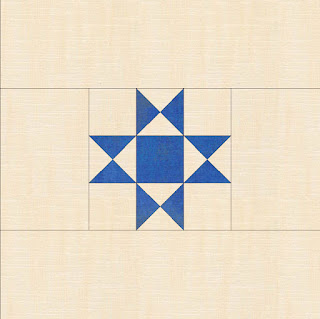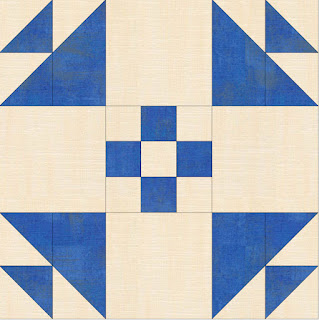Here is the math for computing any-sized LeMoyne Star.
❤No, you don't have to read this post if you think your head will explode--mine almost did writing it. I have done all of the math for you on this LeMoyne Star Calculator Google Docs Spreadsheet. Just enter your finished block size. You can also download the sheet for your personal use.
Nebbish notes: I had to do a little math fidgeting using Precise, Ceiling and Floor math so that the 1/8th measurements came out correctly. We can only measure to 1/8th, but I had to do some 1/64th rounding etc. Ugh. To share easily on Google Docs I had to abandon more than 3 decades of Excel knowledge and figure out where everything else is in Google Docs. It's like shopping in a different grocery store. You have needful things but you don't f-💣 know where it is.
Ultimately, the finished size of your block has to equal 2 x corner squares and 2 x diamond width.
But read on to understand, intrinsically, how all of this works together. Hopefully it will solidify your understanding, as it did for me. I have excel programmed so I can do this easily. Further, this block is one that you have to make many times to hone your skills. There is NO forgiven
Below is the schematic of a LeMoyne Star.
Notice the relationship of each of the elements.
The LeMoyne Star is composed of three components on the outside of each of its 4 sides.
- 2 squares of equal size
- 1 triangle which is the hypotenuse of the square
Notice that the triangle shares the opposite side of the diamond with the square. Accordingly, we know that measurement is the same length as the square. Therefore, the long side of the triangle is the diagonal or hypotenuse of the square.
Pythagoras tells us that length of the hypotenuse is the side of the square multiplied by 1.414 (the square root of 2).
THEREFORE if we know the square size we can calculate away. How do we do that?
Consider the schematic, and then read on.
Let's do math!
As you can see, we have 3 elements of indeterminate length along each side. What we do know is the finished size of our block!
- Let X = Finished Size of Square. We have 2 squares.
- Let 1.414 X = the hypotenuse of the square which is the long edge of the QST. (Cut a square this size and slice on both diagonals.
Now we know the length of the side by expressing the components of the side, 2 squares and a QST each expressed in terms of X. (You remember you past self mumbling about when would you ever use this stuff!).
THEREFORE: X + X + 1.414 X = Finished Block Size (FB)
OR 3.414X (X + X + 1.414X) = FB
THEREFORE Square calculation: FB/3.414 = X + .5" seam allowance for cut size.
THEREFORE QST Calculation: ( FB/3.414) * 1.414 = the size of the QST Square + 1.25" seam allowance for cut size.
THEREFORE Diamond Calculation: FB/2 - X + .5" Seam Allowance. It can also be expressed as .707X (.707 is 1/2 of 1.414)
When traveling the middle of the block (we were crawling around the edge before) the block is comprised of two diamonds and two squares.
So there you have all of the calculations that you need to compute all of the components of a LeMoyne Star.
Let's Do More Math with Real Examples!
Let's compute the components of an 11" Finished Block. I highlighted the square components so that you can easily see how they figure in each of the computations.
When computing elements, round up to nearest 8th because you can only measure to that discrete of a unit. When I originally devised this scheme, I computed each of the components using the math expressed here. Later, when I purchased my EQ8 program, I checked the math on EACH of the sizes (I did 1/2" increments)
Example 1: Finished Block (FB) = 11.
- Square = FB/3.414 or 11/3.414 or 3.25 + .5" = cut block of 3.75"
- QST = 1.414 x Square or 3.25 x 1.414 or 4.5 + 1.25" = cut block of 5.75 cut on 2 diagonals.
- Diamonds: 2 diamonds = 11 - 3.25 - 3.25 or 4.5"
- 1 diamond = 4.5/2 or 2.25 + .5" seam allowance = cut diamond strip height (and width!) of 2.75
Example 2: Finished Block = 5"
- Square = FB/3.414 or 5/3.414 or 1.5 + .5 = 2" cut square.
- QST = Square x 1.414 x 1.5 or 2.125 + 1.25 = 3 3/8 cut square cut on 2 diagonals
- Diamonds = FB - 2 Squares = 2 Diamonds or 5 - 1.5 - 1.5 = 2. 2/2 = 1 + .5 = 1.5" diamond height/width.
- Alternatively FB/2 - Square = Diamond
If you have compound blocks, simply add more X's or 1.414 X's to compute the components of the finished block. You will use that as your divisor.
Let's do even more math!
Have a jelly roll that you would like to use as your diamonds? How is that going to work?
EXAMPLE 1: Jelly roll 2.5" strip. Cut strip is a jelly roll that you wish to make your diamonds from: 2.5 is cut. -.5" = Finished Therefore we are looking for a block that uses a 2" finished diamond.
The diamond expressed in terms of the square and the size of the FB is the same. Refer to the drawing. Another way to express the diamond is below.
X + X + .5(1.414X) + .5(1.414X) = FB
Therefore, a single diamond = .707 (.5*1.414) of X. .707X=finished diamond.
Our Finished Diamond = 2
THEREFORE Square = 2/.707 or 2.828. Here we have to round down to 2.75.
If 2.75 is our square, we know that 2.75*3.414 = 9.5 the size our our finished block.
EXAMPLE 2: You have 3" strips that you have cut for a project that you don't wish to trim down. You wonder, "What size LeMoyne Star can I make?"
Single Diamond Finished = .707X is our finished diamond math. We know that our finished diamond = 3; Therefore our square = 3/.707 or 4.25
FB = 4.25 x 3.414 or 14.5" finished block.
If you wish not to do math, you can simply enter FB sizes in the google docs spreadsheet until you get what you want. I will call you a math woos!
Now you can see why I made the calculator of you.
















































